Articles
- Page Path
- HOME > Restor Dent Endod > Volume 28(3); 2003 > Article
- Original Article Shear bond strength of self-etching adhesives to dentin and sem analysis
- Young-Gon Cho, Kee-Sun Roh, Soo-Mee Kim, Young-Gon Lee, Jin-Ho Jeong, Young-Jae Ki
-
2003;28(3):-231.
DOI: https://doi.org/10.5395/JKACD.2003.28.3.222
Published online: May 31, 2003
Department of Conservative Dentistry, College of Dentistry, Chosun University, Korea.
- Corresponding author (ygcho@mail.chosun.ac.kr)
Copyright © 2003 Korean Academy of Conservative Dentistry
- 819 Views
- 1 Download
- 1 Crossref
Abstract
-
The purpose of this study was to compare shear bond strength and interfacial pattern of composite bonded to dentin using self-etching adhesive systems.Sixty extracted human molars with exposed occlusal dentin were divided into four groups and bonded with four adhesives and composites: Single Bond/Filtek Z 250(SB), Tyrian SPE-One-Step Plus/Aelitefil(TY), Prompt L-Pop/Filtek Z 250(LP), and One-Up Bond F/Palfique Toughwell(OU).The results of this study were as follows;
Shear bond strength for OU was significantly lower than that of other groups(p<0.05). No significant difference was founded among SB, TY, and LP.
Failure modes to dentin showed adhesive and mixed for SB, TY, and LP, but them for OU showed adhesive in all spceimens.
Dentin-resin interface showed close adaptation for SB, TY, and LP, but it showed gap for OU.
The hybrid layers for TY, LP, OU were thinner than that of SB. Adhesive layers were observed between composite and hybrid layer, which were 5 µm thick for TY and 10 µm thick for OU.
- 1. Santini A, Plasschaert AJM, Mitchell S. Effect of composite resin placement techniques on the microleakage of two self-etching dentin-bonding agents. Am J Dent. 2001;14(3):132-136.PubMed
- 2. Perdigão J, Frankenberger R, Rosa BT, Breschi L. New trends in dentin/enamel adhesion. Am J Dent. 2000;13(Special issue):25D-30D.PubMed
- 3. Sonoda H, Sasafuchi Y, Kitasako Y, Arakawa M, Otsuki M, Tagami J. Pulpal response to a fluoride-releasing all-in-one resin bonding system. Oper Dent. 2002;27: 271-277.PubMed
- 4. Zheng L, Pereira PN, Nakajima M, Sano H, Tagami J. Relationship between adhesive thickness and microtensile bond strength. Oper Dent. 2001;26: 97-104.PubMed
- 5. Inoue S, Van Meerbeek B, Vargas M, Yoshida Y, Lambrechts P, Vanherle G. Adhesion mechanism of self-etching adhesives. 1999;Advanced Adhesive Dentistry 3rd international Kuraray symposium. 131-148.
- 6. Miyazaki M, Onose H, Moore BK. Effect of operator variability on dentin bond strength of two-step bonding systems. Am J Dent. 2000;13(2):101-104.PubMed
- 7. Bouillaguet S, Gysi P, Wataha JC, Ciucchi B, Cattani M, Godin CH, Meyer JM. Bond strength of composite to dentin using conventional, one-step, and self-etching adhesive systems. J Dent. 2001;29: 55-61.ArticlePubMed
- 8. Tay FR, Gwinnett JA, Wei SH. Micromorphological spectrum from overdrying to overwetting acid-conditioned dentin in water-free, acetone-based, single bottle primer/adhesives. Dent Mater. 1996;12: 236-244.ArticlePubMed
- 9. Cho YG, Cho KC. Marginal Microleakage of Self-etching Primer Adhesives and a Self-etching Adhesive. J Korean Acad Conserv Dent. 2002;27(5):493-501.Article
- 10. Agostini FG, Kaaden C, Powers JM. Bond strength of self-etching primers to enamel and dentin of primary teeth. Pediatr Dent. 2001;23(6):481-486.PubMed
- 11. Brackett WW, Covey DA, St Germain HA. One-year clinical performance of a self-etching adhesive in class V resin composites cured by two methods. Oper Dent. 2002;27: 218-222.PubMed
- 12. Frey O. Creating a reliable bond. An all-in-one system. Am J Dent. 2000;13(Special issue):85D-87D.PubMed
- 13. Hashimoto M, Ohno H, Kaga M, Endo K, Sano H, Oguchi H. Fractographical analysis of resin-dentin bonds. Am J Dent. 2001;14(6):355-360.PubMed
- 14. Li H, Burrow MF, Tyas MJ. The effect of load cycling on the nanoleakage of dentin bonding systems. Dent Mater. 2002;18: 111-119.ArticlePubMed
- 15. Pontes DG, de Melo AT, Monnerat AF. Microleakage of new all-in-one adhesive systems on dentinal and enamel margins. Quintessence Int. 2002;33(2):136-139.PubMed
- 16. Yoshiyama M, Matsuo T, Ebisu S, Pashley D. Regional bond strengths of self-etching/self-priming adhesive systems. J Dent. 1998;26: 609-616.ArticlePubMed
- 17. Hannig M, Fu B. Effect of air abrasion and resin composite on microleakage of class V restorations bonded with self-etching primers. J Adhes Dent. 2001;3: 265-272.PubMed
- 18. Prati C, Chersoni S, Mongiorgi R, Pashley DH. Resin-infiltrated dentin layer formation of new bonding systems. Oper Dent. 1998;23: 185-194.PubMed
- 19. Yoshiyama M, Urayama A, Kimochi T, Matsuo T, Pashley DH. Comparison of conventional vs self-etching adhesive bonds to caries-affected dentin. Oper Dent. 2000;25: 163-169.PubMed
- 20. Kazemi RB, Meiers JC, Peppers K. Effect of caries disclosing agents on bond strengths of total-etch and self-etching primer dentin bonding systems to resin composite. Oper Dent. 2002;27: 238-242.PubMed
- 21. Toledano M, Osorio R, de Leonardi G, Rosales-Leal JI, Ceballos L, Cabrerizo-Vilchez MA. Influence of self-etching primer on the resin adhesion to enamel and dentin. Am J Dent. 2001;14(4):205-210.PubMed
- 22. Yoshiyama M, Carvalho R, Sano H, Horner JA, Brewer PD, Pashley DH. Regional bond strengths of resins to human root dentine. J Dent. 1996;24: 435-442.ArticlePubMed
- 23. Pereira PNR, Okuda M, Nakajima M, Sano H, Tagami J, Pashley DH. Relationship between bond strengths and nanoleakage: evaluation of a new assessment method. Am J Dent. 2001;14(2):100-104.PubMed
- 24. Croll TP. Self-etching adhesive system for resin bonding. ASDC J Dent Child. 2000;176-181.PubMed
- 25. Miyazaki M, Iwasaki K, Onose H, Moore BK. Enamel and dentin bond strengths of single application bonding systems. Am J Dent. 2001;14(6):361-366.PubMed
- 26. Tay FR, King NM, Shu BI, Pashley DH. Effect of delayed activation of light-cured resin composites on bonding of all-in-one adhesives. J Adhes Dent. 2001;3: 207-225.PubMed
- 27. Abdalla AI, Garcia-Godoy F. Morphological characterization of single bottle adhesives and vital dentin interface. Am J Dent. 2002;15(1):31-34.PubMed
- 28. da Silva Telles PD, Aparecida M, Machado M, Nör JE. SEM study of a self-etching primer adhesive system used for dentin bonding in primary and permanent teeth. Pediatr Dent. 2001;23(4):315-320.PubMed
- 29. Tay FR, Pashley DH. Aggressiveness of contemporary self-etching systems. I: Depth of penetration beyond dentin smear layers. Dent Mater. 2001;17: 296-308.PubMed
- 30. Nikaido T, Kunzelmann KH, Chen H, Ogata M, Harada N, Yamaguchi S, Cox CF, Hickel R, Tagami J. Evaluation of thermal cycling and mechanical loading on bond strength of a self-etching primer system to dentin. Dent Mater. 2002;18: 269-275.ArticlePubMed
- 31. Gallo JR, Henderson M, Burgess JO. Shear bond strength to moist and dry dentin of four dentin bonding systems. Am J Dent. 2000;13(5):267-270.PubMed
- 32. Ferrari M, Mason PN, Vichi A, Davidson CL. Role of hybridization on marginal leakage and bond strength. Am J Dent. 2000;13(6):329-336.PubMed
REFERENCES
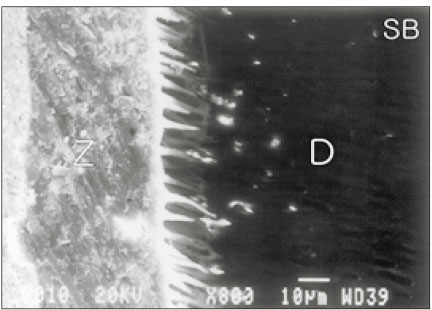
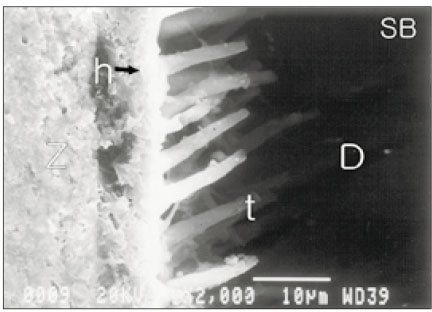
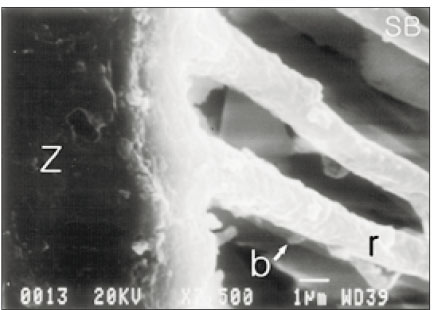
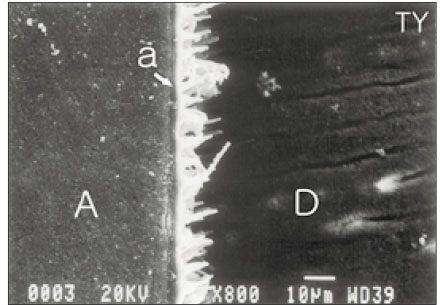
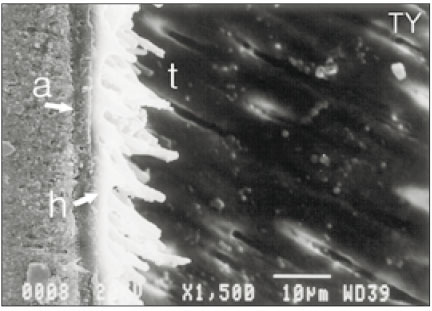
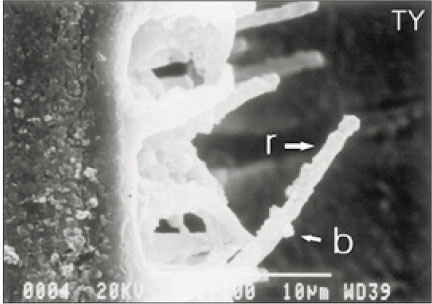
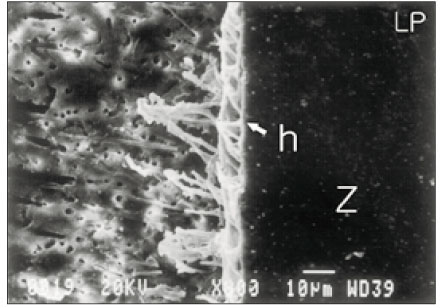
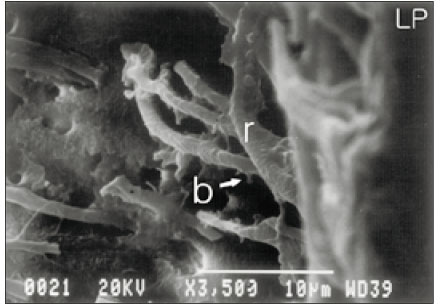

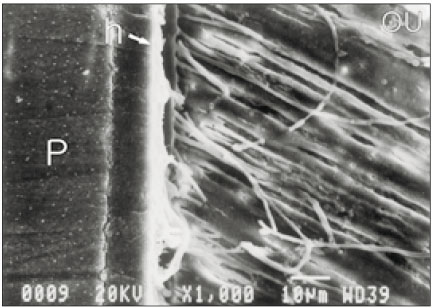
Tables & Figures
REFERENCES
Citations

- POSITIONING SELF‐ETCHING ADHESIVES: VERSUS OR IN ADDITION TO PHOSPHORIC ACID ETCHING?
Claus‐Peter Ernst
Journal of Esthetic and Restorative Dentistry.2004; 16(1): 57. CrossRef







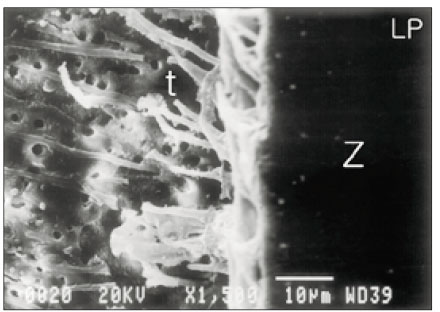

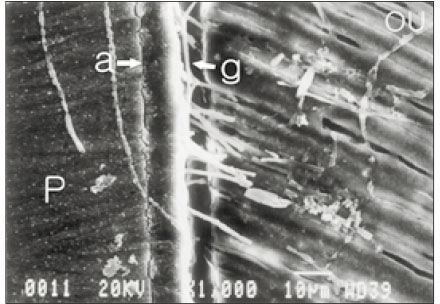

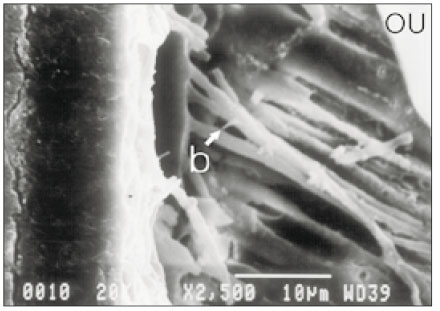
Fig. 1
Fig. 2
Fig. 3
Fig. 4
Fig. 5
Fig. 6
Fig. 7
Fig. 8
Fig. 9
Fig. 10
Fig. 11
Fig. 12
Group classification of an one-bottle adhesive and three self-etching adhesives/composite resins used in this study.
Shear bond strength (MPa) to dentin and failure mode after the test
*: there was statistically significant difference among groups by Tukey's test (p<0.05).
*: there was statistically significant difference among groups by Tukey's test (p<0.05).

 KACD
KACD




 ePub Link
ePub Link Cite
Cite

